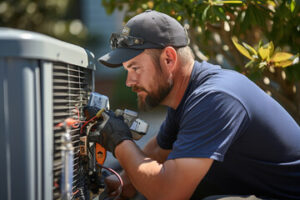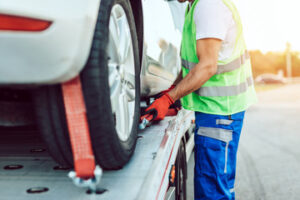Air Conditioning Repair Round Rock TX is essential for maintaining the efficiency and functionality of cooling systems. When an air conditioning unit starts to show signs of malfunction, addressing the problem promptly can prevent more significant damage and costly repairs.

Air conditioning systems are complex machines composed of various components working together to regulate indoor temperature and humidity levels. Over time, these components can wear down or fail due to continuous use, exposure to environmental factors, and lack of regular maintenance. Understanding the importance of timely repair and recognizing early signs of trouble can help maintain consistent performance and improve the lifespan of the unit.
One of the most common signs that an air conditioning system requires repair is reduced cooling efficiency. If the unit struggles to maintain the desired temperature or takes longer than usual to cool a room, it may be due to issues such as a refrigerant leak, clogged filters, or malfunctioning compressors. Refrigerant leaks are particularly problematic because they not only compromise cooling performance but also pose environmental hazards. Repairing a refrigerant leak involves locating the source of the leak, sealing it properly, and recharging the system with the correct refrigerant levels. Clogged or dirty filters can restrict airflow, forcing the system to work harder and consume more energy. Regularly cleaning or replacing filters is a simple but effective way to prevent this issue and ensure proper airflow.
Strange noises coming from the air conditioning unit often indicate mechanical problems that require immediate attention. Grinding, squealing, or rattling sounds may result from loose or damaged components, such as fan blades, belts, or motor bearings. Ignoring these noises can lead to further damage and potential system failure. A professional technician can inspect the system, identify the source of the noise, and repair or replace the affected parts. Proper lubrication of moving parts and tightening of loose components can often resolve these issues and restore quiet operation. Additionally, a buzzing sound may indicate electrical problems, such as faulty wiring or a failing capacitor, which should be addressed by a qualified technician to avoid safety risks.
Poor airflow is another indication that an air conditioning system may need repair. Weak or uneven airflow can result from blocked ducts, damaged fans, or malfunctioning blowers. Ductwork should be inspected for leaks, obstructions, and poor insulation, as these issues can compromise the efficiency of the system and increase energy consumption. Cleaning the evaporator and condenser coils can also improve airflow and enhance cooling performance. A professional technician can perform a thorough inspection of the duct system, identify any blockages or damage, and recommend appropriate repairs or replacements to restore proper airflow and efficiency.
Frequent cycling or short cycling, where the air conditioning unit turns on and off repeatedly within a short period, can indicate underlying problems. Short cycling can be caused by an oversized unit, a faulty thermostat, or a malfunctioning compressor. An oversized unit may cool the space too quickly, leading to rapid cycling and increased wear on the system. Adjusting the size of the unit or recalibrating the thermostat can help resolve this issue. If the compressor is malfunctioning, it may need to be repaired or replaced to ensure proper operation. Short cycling not only reduces comfort levels but also increases energy consumption and shortens the lifespan of the system.
Water leaks around the air conditioning unit can indicate a clogged condensate drain line, a frozen evaporator coil, or a damaged drain pan. When the condensate drain line becomes clogged with dirt and debris, water can back up and overflow, causing damage to floors, walls, and ceilings. Clearing the drain line and ensuring proper drainage can prevent water damage and restore normal operation. A frozen evaporator coil may result from restricted airflow, low refrigerant levels, or a dirty coil surface. Thawing the coil and addressing the underlying cause can prevent the problem from recurring. Repairing or replacing a damaged drain pan can also help prevent leaks and maintain the integrity of the system.
High humidity levels indoors despite the air conditioning system running may signal a malfunctioning dehumidification process. Air conditioning systems are designed to regulate humidity levels by removing excess moisture from the air during the cooling process. If the system fails to control humidity, it may be due to an oversized unit, a faulty thermostat, or dirty coils. Adjusting the size of the unit, recalibrating the thermostat, and cleaning the coils can help restore proper humidity control. Installing a dedicated dehumidifier or upgrading to a system with enhanced humidity control features may also improve indoor comfort and air quality.
Electrical problems are a common cause of air conditioning failure and require immediate attention to avoid safety hazards. Faulty wiring, tripped circuit breakers, and damaged capacitors can prevent the system from starting or cause it to shut down unexpectedly. Professional technicians can diagnose electrical issues using specialized equipment and repair or replace damaged components to restore proper operation. Ensuring that the electrical system is properly grounded and that all connections are secure can prevent future problems and improve the overall safety of the system.
A frozen evaporator coil is a frequent issue that requires prompt repair. When the evaporator coil becomes covered in ice, it restricts airflow and reduces cooling efficiency. Low refrigerant levels, dirty filters, and blocked ducts can contribute to coil freezing. Thawing the coil and addressing the underlying cause, such as refilling refrigerant or cleaning the filters, can prevent the problem from recurring. Proper airflow and refrigerant levels are essential for maintaining efficient cooling performance and preventing coil freezing.
Compressor failure is one of the most serious issues that can affect an air conditioning system. The compressor is responsible for circulating refrigerant through the system and facilitating the heat exchange process. If the compressor fails, the entire system will be unable to cool effectively. Compressor failure can result from electrical problems, refrigerant imbalances, or overheating. Repairing or replacing a compressor is a complex task that requires specialized knowledge and equipment. Ensuring that the system is properly charged with refrigerant, maintaining clean coils, and addressing electrical issues can help prevent compressor failure and extend the lifespan of the system.
Thermostat malfunctions can cause inconsistent temperature control and reduce the overall efficiency of the air conditioning system. If the thermostat is not calibrated correctly, it may cause the system to cycle too frequently or fail to reach the desired temperature. Upgrading to a programmable or smart thermostat can improve temperature control and enhance energy efficiency. Professional installation and calibration of the thermostat ensure accurate temperature readings and consistent comfort. Adjusting the thermostat settings based on occupancy patterns and seasonal changes can further improve performance and reduce energy consumption.
Preventive maintenance plays a crucial role in reducing the need for major air conditioning repairs. Scheduling regular inspections and tune-ups helps identify and address minor issues before they escalate into costly problems. Maintenance tasks such as cleaning or replacing filters, inspecting ductwork, checking refrigerant levels, and lubricating moving parts improve system efficiency and reliability. Professional technicians can also test electrical connections, calibrate thermostats, and clean coils to maintain optimal performance. Regular maintenance extends the lifespan of the system, improves indoor comfort, and reduces energy costs.
Investing in professional air conditioning repair services ensures that the system operates at peak efficiency and provides reliable comfort. Skilled technicians have the knowledge and experience to diagnose complex issues, perform accurate repairs, and recommend appropriate upgrades or replacements. Addressing repair issues promptly prevents further damage, reduces energy consumption, and improves overall system performance. Maintaining a well-functioning air conditioning system enhances indoor comfort, protects property value, and contributes to a healthier living environment. Recognizing early signs of trouble and relying on professional repair services helps ensure that the system remains dependable and efficient for years to come.

